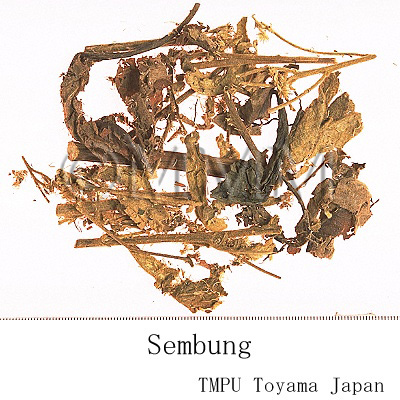Crude drug sample data base
※Click on the image to enlarge it.
Scientific information data base
| Crude drug name | Indonesian name, English name | Daun sembung, Ngai camphor plant | ||||
|---|---|---|---|---|---|---|
| crude drug image |
| |||||
| Original plant name | Blumea balsamifera DC. | |||||
| Family name | Compositae | |||||
| Used part | Leaves | |||||
| Distribution area | From India, Burma, Indo-China, southern China and Taiwan to Thailand, Malaysia, Indonesia and the Philippines. It grows wild throughout Java Island, from lowland to highland up to 2000 m altitude, in sunny to slightly shaded places in grasslands, fields, roadsides, also as ornamental [201, 205]. | |||||
| Description | Leaves: oblong-lanceolate, 6-30 cm x 1.5-12 cm, tapering at base, margin serrate to pinnately lobed, densely silky-woolly below. Odour: camphoric; taste: slightly bitter The plant is a shrub, up to 4 m tall, stem erect, densely woolly-villous. Flowers marginal, disk flowers, whitish or reddish-yellow [205] | |||||
| Drug effect | Pungent, slightly sweet, warming, improving blood circulation [231]. | |||||
| Specific actions | Diaphoretic, expectorant, diuretic, antirheumatic [231]. | |||||
| Frequency in use | Moderate. | |||||
| Common uses | Crystals of camphor called kamferngai are obtained during the distillation of essential oil from the leaves [201]. | |||||
| Pharmacological effect | Blumeatin isolated from B. balsamifera could protect the liver against injury induced by CCl4 and thioacetamide [205]. B. balsamifera has antihistamine release properties and antifungal activity of the ethanolic extract [205]. A study on the antifungal property of ichtyothereol acetate and cryptomeridiol obtained from the leaves of Blumea balsamifera showed that ichtyothereol acetate has moderate activity against the fungi Aspergillus niger, Trichophyton mentagrophytes and Candida albicans, while cryptomeridiol has low activity against A. niger, T. mentagrophytes and C. albicans [PMID:15702636]]. | |||||
| Medical system | Indonesian medicine (Jamu) | |||||
| Traditional usage | It is used as an appetite stimulant and strengthen the abdomen. As a sudorific it is used to treat beri-beri ,weaknesses, fever. It is for treating stomach cramps and other stomach disorders, menorrhagia, respiratory disorders, malaria, gallbladder disorders, aphthae. It is also used to stop nose bleeding and circumcision bleeding. Hot steepings of the leaves in water is a good sudorific which is beneficial for treating diseases of the chest [201]. | |||||
| Formulation | 1) Anorexia and abdominal weakness: The steeping from the young roots is drunk as an appetite stimulant and strengthen of the abdomen. Some people prefer to use the decoction of fresh or dried leaves for the same purpose [201]. 2) Fatigue and beri-beri: A combination with leaves of Vitex trifolia, Psidium guajava and Citrus sp. can be used as a diaphoretics in patients suffered from weakness due to chronic fatique syndrome or diseases. It also used to treat patients suffered from beri-beri. In this case, the mixture is used for bathing or steambathing [201]. 3) Flatulence and menorrhagia: Decoction of a mixture of the leaves and other vegetables. 4) Malaria: Take a herbal tea made from leaves, or use the decoction for steambathing [201]. 5) Spasm: Drink the mixture of the decoction of the leaves and peppermint oil. 6) Dysmenorrhea: Roasted Parkia biglobosa seeds in powdered form combined with the leaves to make a decoction [201]. 7) Abscesses, skin eruption, bruises: Apply the decoction of the leaves externally to the affected areas [201]. | |||||
| References | Reference book Tips! | [201] K. Heyne, Tumbuhan Berguna Indonesia, Vols. 1-4, 1987. Diedarkan Oleh Koperasi Karyawan Departemen Kehutanan, Jakarta, Indonesia. Vol. 3, pp 1829-1831. [205] de Pdua, L.S., Bunyapraphatsara, N. and Lemmens, R.H.M.J. (Editors), 1990. Plant Resources of South-East Asia No. 12 (1). Medicinal and poisonous plants 1. Backhuys Publishers, Leiden, Netherlands. pp 158-159. [231] Soedibyo, Mooryati: Alam Sumber Kesehatan: Manfaat dan Kegunaan (Natural resources for health. Benefits and uses). Balai Pustaka. 1998. pp 339-340. | ||||
| Research paper | 1. Osaki N, Koyano T, Kowithayakorn T, Hayashi M, Komiyama K, Ishibashi M. Sesquiterpenoids and plasmin-inhibitory flavonoids from Blumea balsamifera. J Nat Prod. 68(3):447-9, 2005. (PMID: 15787457) 2. Ragasa CY, Co AL, Rideout JA. Antifungal metabolites from Blumea balsamifera. Nat Prod Res. 19(3):231-7, 2005. (PMID: 15702636) 3. Ali DM, Wong KC, Lim PK. Flavonoids fromBlumea balsamifera. Fitoterapia. 76(1):128-30, 2005. (PMID: 15664477) 4. Stockman R. The Physiological Action of Borneol. A Contribution to the Pharmacology of the Camphor Group. J Physiol. 9(2-3):65-91, 1888. (PMID: 16991497) | |||||
| Remarks | It is well known as the source of camphor, namely Ngai camphor, which is obtained in crystal form [PMID:16991497]. | |||||
| Last renewal date | 2024/03/04 | |||||





